In the late 19th century, the Maxwell Street Market in Chicago spontaneously emerged as a bustling hub on the near south side. This area, populated by newly arrived immigrants from Jewish, Italian, and other backgrounds, quickly became a melting pot of cultures and commerce. Driven by the immigrant spirit of seeking value and opportunity, Maxwell Street transformed into a vibrant marketplace renowned for its bargains, eclectic goods, and, notably, its diverse culinary offerings. Where people gathered, food naturally followed, and in its early days, the market was characterized by the aromas and tastes of deli foods.
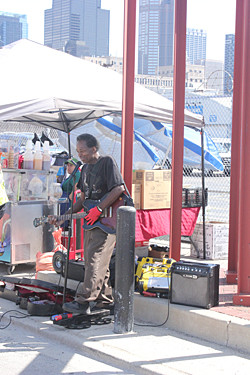 Chicago bluesman playing at Maxwell Street Market
Chicago bluesman playing at Maxwell Street Market
The demographic landscape of Maxwell Street shifted significantly during the Great Migration, as African Americans from the South moved to Chicago. This influx brought with it new cultural dimensions, most notably the sounds of blues music which became synonymous with Chicago’s urban identity. Alongside the music, Southern culinary traditions took root, with barbecue stands appearing alongside the established corned beef vendors. This vibrant era of Maxwell Street is famously captured in the 1980s film The Blues Brothers, featuring John Lee Hooker performing amidst the market’s energy in front of “Soul Food Cafe” (actually Nate’s Delicatessen).
In 1994, the original Maxwell Street Market was relocated to make way for the development of University Village. Initially moving to Canal Street, the market eventually found its current home on Desplaines Street, between Polk and Taylor. Every Sunday, from 7 am to 3 pm, the Maxwell Street Market Chicago comes alive with a predominantly Mexican flavor. The air is thick with the enticing scents of masa and lard-fried delicacies, punctuated by hints of barbecue and Polish sausage, reflecting the market’s evolving culinary tapestry.
The Maxwell Street Market is a dynamic entity, changing in size and vendor composition from week to week, making it a constantly evolving experience. This fluidity presents a unique challenge in creating a definitive guide. To provide enduring value, this guide focuses on vendors and food offerings that have established a consistent presence within the market. Consider these guides as different approaches to navigate and appreciate the vibrant chaos that is Maxwell Street.
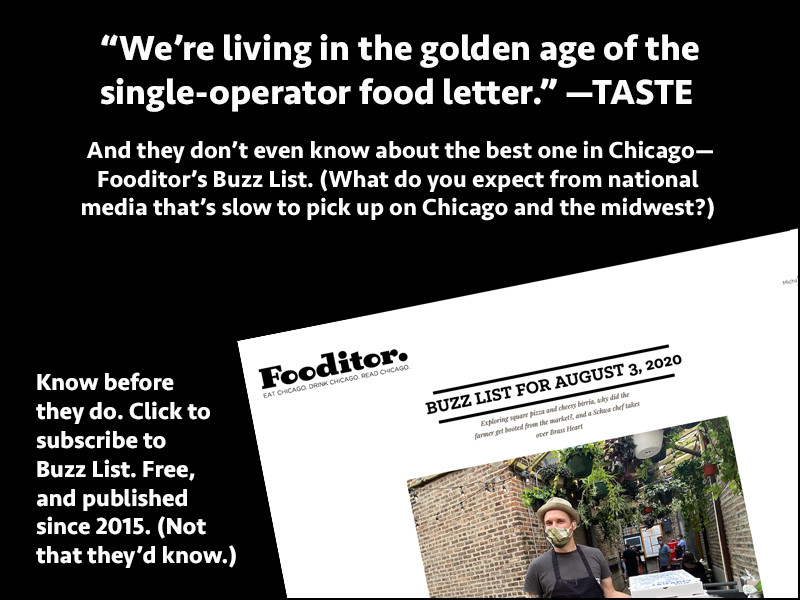 Advertisement banner for local businesses
Advertisement banner for local businesses
Guide 1: Must-Try Market Chow at Maxwell Street Market
Specific food vendors tend to congregate in certain areas of the market. This guide is structured from north (around Polk on Desplaines) to south (towards Taylor or Roosevelt), helping you navigate the culinary landscape. For those driving, parking north of Roosevelt, near Polk, offers metered street parking, typically around $4 per hour. Be aware of ongoing street construction that might require parking adjustments. Alternatively, the Red Line’s Roosevelt stop provides convenient access, followed by a short walk west.
These are the undisputed culinary stars of Maxwell Street Market, the vendors that transform first-time visitors into lifelong regulars.
Rubi’s – Authentic Taco Experience
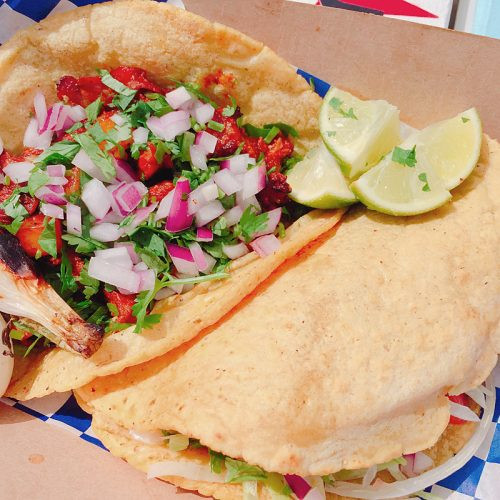 Delicious Taco al pastor from Rubi's stand at Maxwell Street Market
Delicious Taco al pastor from Rubi's stand at Maxwell Street Market
Location: North end/West side
If you arrive early, Rubi’s is a must-visit. Renowned for their quesadillas and highly sought-after tacos, Rubi’s uses freshly made tortillas as the foundation for generous servings of meat and cheese, topped with cilantro and onions. Despite an efficient serving line, even a short queue can take around 20 minutes, and by midday, lines can extend to over 60 people. While Rubi’s tacos are undeniably delicious, consider arriving before the peak crowds to avoid lengthy waits. The steak (asada) taco ($3.00) is a popular choice, but the taco al pastor, subtly flavored with pineapple and featuring grilled bulb onions, is also highly recommended.
Tamal Oaxaca – Traditional Oaxacan Tamales
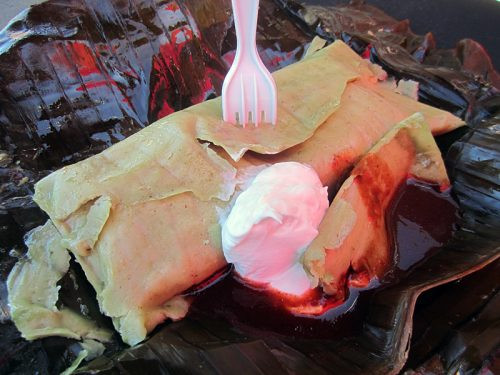 Authentic Oaxacan tamal served in banana leaf at Maxwell Street Market
Authentic Oaxacan tamal served in banana leaf at Maxwell Street Market
Location: North end/East side
For over 15 years, a visit to Tamal Oaxaca has been a personal tradition at Maxwell Street Market. The Oaxaca tamale verde ($3.50) is a standout, featuring tender chicken enveloped in moist corn flour, steamed in a banana leaf, and served with salsa verde or rich red mole. A dollop of crema, a cultured cream, adds a crucial lushness that balances the salsa’s flavors perfectly. These substantial tamales reheat well in a microwave, retaining their moisture when warmed in their banana leaf. For a take-home option, the pozole (hominy and pork soup) is an excellent value at $6, including chips, salsas, and garnishes like lettuce, onion, and radish.
Tacos Bernardo – Unique Taco Varieties
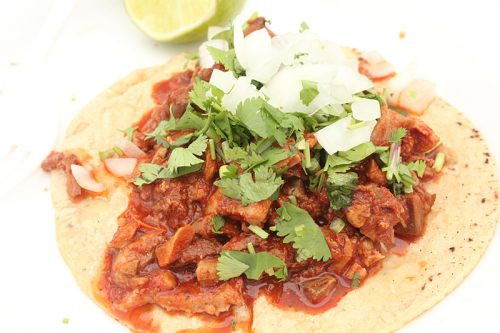 Montalayo taco with unique meat mix at Tacos Bernardo Maxwell Street Market
Montalayo taco with unique meat mix at Tacos Bernardo Maxwell Street Market
Location: Middle/East side
Like many vendors at Maxwell Street Market, Tacos Bernardo prides itself on hand-made tortillas – fresh, soft, absorbent, yet sturdy enough to hold generous fillings. During warmer months, tables are adorned with Styrofoam cups filled with papalo, a mild herb popular in Mexican cuisine. Papalo, an ancient herb with purported medicinal properties, is believed to aid digestion. Its mild flavor makes it a pleasant addition to your tacos, potentially preempting any stomach discomfort. For the adventurous palate, the montalayo taco ($2) is a bold choice. This features a spicy red sauce and a mix of organ meats, typically cow stomach, and potentially esophagus, spleen, and liver. The strong flavors are surprisingly balanced by the classic onion-cilantro topping.
Tacos Arroyos – Adventurous Dining Options
 Vendor Michael Gebert at Tacos Arroyos stand in Maxwell Street Market
Vendor Michael Gebert at Tacos Arroyos stand in Maxwell Street Market
Location: Middle/East side
Maxwell Street Market was once known for vendors offering eyeball tacos, a quintessential “bragging rights” food for adventurous eaters. While those may be harder to find now, Tacos Arroyos keeps the spirit of adventurous dining alive with options like buche tacos. Their tacos ($2 each) are all flavorful, but the buche taco, filled with pork stomach cooked in pork fat, stands out. This rich and flavorful taco is not for the faint of heart, but for those looking to explore the more unconventional side of Maxwell Street Market’s culinary offerings, Tacos Arroyos, along with Tacos Bernardo, represent some of the last bastions of unique and offal-centric street food.
Xurro – Freshly Made Churros
 Xurro churro truck serving fresh pastries at Maxwell Street Market
Xurro churro truck serving fresh pastries at Maxwell Street Market
Location: Middle/West side
Churros are a common sight in bodegas and from street vendors in Hispanic neighborhoods, often pre-made and of varying quality. Xurro offers a stark contrast – their churros are fried fresh and served hot, a world apart from day-old versions. These pastries are crispy on the outside, cakey on the inside, and dusted with sugar. While Xurro has an outlet at Navy Pier, their Maxwell Street Market operation maintains the same commitment to freshness and quality, delivering churros as good as you can imagine.
Coctel de Fruta – Mangonadas and Fruit Cocktails
 Refreshing Coctel de Fruta stand with fruit drinks at Maxwell Street Market
Refreshing Coctel de Fruta stand with fruit drinks at Maxwell Street Market
Location: South end/East side
While Coctel de Fruta offers standard fruit cocktails, the real draw here is the mangonada. This Mexican frozen treat is a sundae-like concoction of ice cream or sorbet, fresh mango, lime juice, Tajin (chili-lime salt), and chamoy, a complex condiment that balances sweet, sour, and salty flavors. The version at this stand includes a tamarind paste-wrapped straw, adding another layer of flavor. Mangonadas offer a burst of diverse tastes in every spoonful. Variations include vampiros (with spicy mango chunks) and diablitos (with tamarind syrup and hot sauce) for those seeking extra zest.
Guide 2: Quenching Your Thirst at Maxwell Street Market
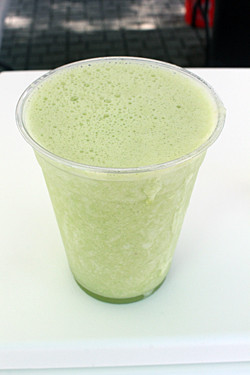 Nopales smoothie at M&J Smoothies stand in Maxwell Street Market
Nopales smoothie at M&J Smoothies stand in Maxwell Street Market
Maxwell Street Market operates on Sunday mornings, so alcoholic beverages are not part of the experience. However, the market boasts a variety of refreshing and flavorful fruit and vegetable-based drinks.
M&J Smoothies. For a unique and healthy option, try the nopales smoothie. Nopales, or cactus paddles, are sometimes found in tacos or carne asada, but at M&J Smoothies, they take center stage. Combined with celery, pineapple, and orange juice, the nopales are blended into a frothy, subtly sweet, light green drink ($4). This smoothie is a refreshing and healthy complement to the market’s spicier food options. M&J also offers smoothies featuring other fruits and vegetables like peach, guava, spinach, and beet.
El Campeon Pina Colada. For a visually striking and tropical drink, El Campeon Pina Colada presents a pineapple with its top removed, hollowed out, and filled with canned pineapple and coconut juice ($8.50). While somewhat touristy in appearance, it’s undeniably a refreshing beverage, perfect for a warm day at the market.
Horchata, Champurrado, Licuados. Stands throughout the market offer classic Mexican beverages. Horchata, a cinnamon-infused rice drink, is a sweet and comforting choice. Champurrado, a hot chocolate atole (corn-based drink), provides warmth and richness. Licuados, fruit-flavored waters in varieties like watermelon and lemon, offer simple and refreshing hydration. All of these beverages pair exceptionally well with Mexican food. For those craving a soda, look for Mexican Coke, which uses real sugar instead of corn syrup, resulting in a cleaner, more authentic flavor. Mexican Coke is available at Rubi’s and other vendors for a slightly higher price but is worth the upgrade.
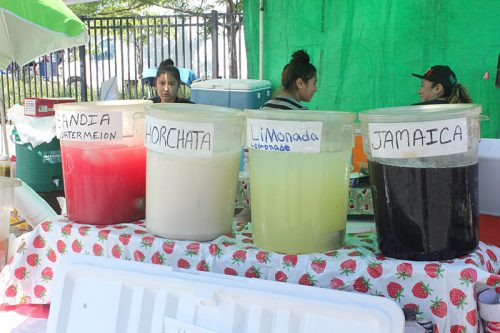 Assorted Licuados at a drink stand in Maxwell Street Market
Assorted Licuados at a drink stand in Maxwell Street Market
Guide 3: Market Staples: Foods Found Throughout Maxwell Street
 Huitlacoche quesadilla from La Flor de Mexico at Maxwell Street Market
Huitlacoche quesadilla from La Flor de Mexico at Maxwell Street Market
Certain foods are ubiquitous at Maxwell Street Market, offered by numerous vendors. This guide highlights these common finds, allowing you to sample them from any vendor that catches your eye.
Huitlacoche. Once considered an exotic delicacy, huitlacoche, a corn fungus often called “corn smut,” has become increasingly accessible. In the early 2000s, it was a rare find in Chicago, even in Mexican restaurants. Now, huitlacoche is readily available at Maxwell Street Market. Its subtly mushroomy flavor and unique black/purple hue add a luxurious touch to tacos and quesadillas. First-timers should try it solo to appreciate its delicate taste.
Flor de Calabaza. Squash blossoms, or flor de calabaza, are tender and delicate, adding a slightly vegetal, albeit sometimes slimy, note to tacos. While traditionally fresh, many market vendors use canned squash blossoms, which still offer a pleasant flavor and texture. They provide a more interesting alternative to standard lettuce, despite their mild flavor.
Huarache. A huarache, meaning “slipper,” is a large, flat masa disk traditionally filled with beans (either black or pinto). Eating a huarache can be messy due to its open-faced nature. If you plan to cut through the thick, chewy masa, consider bringing your own cutlery, as plastic utensils may not suffice.
Elote. From summer into late fall, grilled corn on the cob, or elote, is a market staple. Ears of corn are grilled and then dressed with mayonnaise or Parkay, lime juice, and chili-salt. Served on a stick, it’s elote. When the kernels are cut off the cob, it becomes esquites, which are easier to eat and often served in a cup or bowl.
Torta Ahogada. Literally translated to “drowned sandwich,” the torta ahogada features a French roll filled with meat and generously smothered in tomato sauce. Like the huarache, it’s a messy but delicious eat-in-place dish. Be sure to grab plenty of napkins.
Birria. Birria, a slow-cooked stew, has evolved at Maxwell Street Market. Originally primarily made with goat, it sometimes included goat, and now is often made with beef. Goat has become less common at the market. A taco labeled “goat barbacoa” from Taqueria Flor de Mexico tasted more like beef, but was still flavorful and tender. Both birria and barbacoa are excellent methods for tenderizing and enhancing the flavor of less expensive cuts of meat.
Guide 4: Beyond Food: Bargain Shopping at Maxwell Street Market
 Fashionable clothing items for sale at Maxwell Street Market
Fashionable clothing items for sale at Maxwell Street Market
While Maxwell Street Market is a culinary destination, it also offers a wide array of other goods, often at bargain prices. Beyond the food, there are many items worth exploring, and a few to approach with caution.
Sunglasses. For stylish and inexpensive sunglasses, Maxwell Street Market is the place to shop. Vendors offer a vast selection, from trendy and bold designs to classic Ray-Ban-style knockoffs, typically priced around $5 a pair or two pairs for $6-$10.
Tube socks. Tube socks are an unexpected but prominent offering at Maxwell Street Market. A pack of 10 white tube socks purchased for $5 four years ago has proven remarkably durable for regular gym use, representing an exceptional value. Competition among sock vendors is high, so take your time and compare prices. The abundance of tube sock vendors remains a market mystery, but socks are always a practical necessity.
Fresh produce. Maxwell Street Market can be a great source for affordable produce. A case of 18 delicious yellow mangoes was recently purchased for $8, a significant value. However, be mindful of quality. A past purchase of pineapples turned out to be rotten inside. Inspect produce carefully before buying. The market is also an excellent source for a wide variety of chili peppers in bulk.
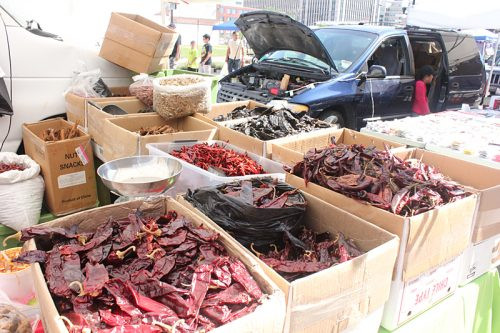 Bulk dried chili peppers for sale at Maxwell Street Market
Bulk dried chili peppers for sale at Maxwell Street Market
Toiletries. Two African-American women vendors at different ends of the market sell soaps that appear to be of good quality. Exercise caution when purchasing mainstream hygiene products like deodorant or shaving cream. Some of these items may be older stock and potentially not stored optimally, possibly affecting their quality.
Electronics. Avoid purchasing major electronics like iPhones or laptops at the market. However, accessory items like earbuds and phone cases can be worthwhile budget-friendly purchases, as the risk is minimal.
T-Shirts. For unique and often outlandish t-shirts, Maxwell Street Market is a treasure trove. Shirts featuring luchadores, the Virgin of Guadalupe, El Chapo, and other figures of Hispanic culture are common and inexpensive. Bargaining is expected. If a shirt is priced at $15, offering $10 might lead to a final price of $12, or even lower with skillful negotiation.
 Author David Hammond and his wife Carolyn Berg enjoying Maxwell Street Market
Author David Hammond and his wife Carolyn Berg enjoying Maxwell Street Market
A Final Tip for Your Visit
Before exploring Maxwell Street Market, remember to bring sunscreen, a hat, and sunglasses, as the pavement can get very hot in the sun.
When parking during warmer months, arrive early and aim for a spot on the east side of a north-south street (like Clinton). This provides afternoon shade, preventing your car from becoming excessively hot.
Consider taking home fresh tortillas. A vendor at Flor de Mexico offers bags of fresh, hand-made tortillas for $7. These are superior to store-bought tortillas and will keep for a few days refrigerated; simply warm them lightly before serving.
This guide is inspired by the experiences and insights of David Hammond, a respected Dining and Drinking editor and contributor to numerous Chicago and national publications, and a founder of LTHForum.com.
[
